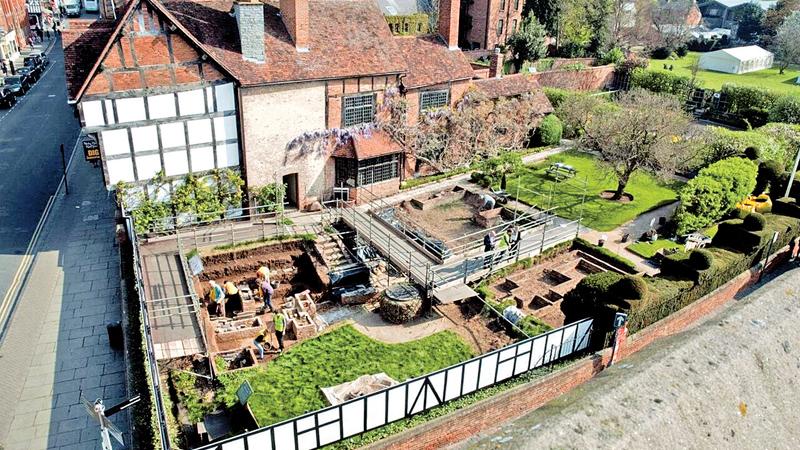
Countless books and articles have been written about the life of William Shakespeare. According to William Mitchell, lecturer in archaeology at the Staffordshire University, these books and articles have initially been based on the scholarly analysis of Shakespeare’s works as well as that of the official records associated with him and his family.
 Mitchell said “Shakespeare’s popularity and legacy endures, despite uncertainties in his life story and debate surrounding his authorship and identity”.
Mitchell said “Shakespeare’s popularity and legacy endures, despite uncertainties in his life story and debate surrounding his authorship and identity”.
Mitchell said that the cutting-edge archaeological methods and interdisciplinary technologies at both ‘New Place’ and his burial place at Holy Trinity Church, Stratford- upon Avon have recently informed about the life and times of William Shakespeare and his family.
New insights
Mitchell said: “The evidence gathered from these investigations by the Centre of Archaeology at Staffordshire University provides new insights into his interests, attitudes and motivations and those of his family- and shows how archaeology can provide further tangible evidence. These complement traditional Shakespearean research methods that have been limited to sparse documentary evidence and the study of his work”.
Mitchell, archaeology has got a remarkable ability of providing a direct connection to a particular individual by means of the objects and places that are associated with them.
It is said that the excavations done in the past on the Shakespearean- era theatres in London have been able to provide valuable evidence with regard to the places where Shakespeare had worked and spent much of his time.
“Attributing objects to Shakespeare is difficult, we have his written work of course, his portrait and memorial bust- but all of his known possessions, like those mentioned in his will, no longer exist.
Signet ring
 A single gold signet ring, inscribed with the initials W. S., is thought by some to be the most significant object owned and used by the poet, despite its questionable provenance”, Mitchell said and added that the most expensive and greatest possession that Shakespeare had was his house, ‘New Place’.
A single gold signet ring, inscribed with the initials W. S., is thought by some to be the most significant object owned and used by the poet, despite its questionable provenance”, Mitchell said and added that the most expensive and greatest possession that Shakespeare had was his house, ‘New Place’.
It is able to have a quantifiable insight into the thought process, private life, and the business success of Shakespeare through the evidence obtained from a recent archaeological investigation of its foundations.
Albeit, the building was lost during the 18th century, underneath a garden, the site as well as its remains had been preserved.
Giving an account on the building, Mitchell said: “erected in the centre of Stratford-upon-Avon more than a century prior to Shakespeare’s purchase in 1597, from its inception, it was architecturally strikingly. One of the largest domestic residences in Stratford, it was the only courtyard-style, open-hall house within the town”.
Shakespeare was more concerned on the outward appearance of the house where he got it installed with a long gallery as well as all the other posh and fashionable architectural embellishments as was expected of a wealthy outstanding gentleman of the time.
Medieval characteristics
Meanwhile, it was also made certain that many other medieval characteristics were also retained. The hall was maintained as a form of a showpiece of his home which was an ideal place that showcased his prosperity as well as popularity.
“Extensive evidence of the personal possessions, diet and the leisure activities of Shakespeare, his family and the inhabitants of New Place were recovered during the archaeological investigations, revolutionising what we understand about his day-to-day life”, Mitchell said.
Further evidence of Shakespeare’s personal and family beliefs have been discovered by the archaeological evidence recovered from non-invasive investigations done at the burial ground of Shakespeare.
Mitchell said, “Multi-Frequency Ground Penetrating Radar (GPR) was used to investigate the Shakespeare family graves below the chancel of Holy Trinity Church”.
The burial ground of Shakespeare is surrounded by some legends among which there are doubts over the presence of a graveyard, that of its contents, stories related to robbing at the grave and the suggestions of a large family crypt.
Moreover, Mitchell said: “The work confirmed that individual shallow graves exist beneath the tombstones and that the various members of Shakespeare’s family were not buried in coffins, but in simple shrouds.
Analysis added that Shakespeare’s grave had been disturbed in the past and that it was likely that his skull had been removed, confirming recorded stories”.

